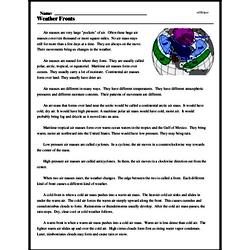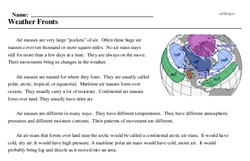Weather Fronts
Air masses are very large "pockets" of air. Often these huge air masses cover ten thousand or more square miles. No air mass stays still for more than a few days at a time. They are always on the move. Their movements bring us changes in the weather.
Air masses are named for where they form. They are usually called polar, arctic, tropical, or equatorial. Maritime air masses form over oceans. They usually carry a lot of moisture. Continental air masses form over land. They usually have drier air.
Air masses are different in many ways. They have different temperatures. They have different atmospheric pressures and different moisture contents. Their patterns of movement are different.
An air mass that forms over land near the arctic would be called a continental arctic air mass. It would have cold, dry air. It would have high pressure. A maritime polar air mass would have cold, moist air. It would probably bring fog and drizzle as it moved into an area.




